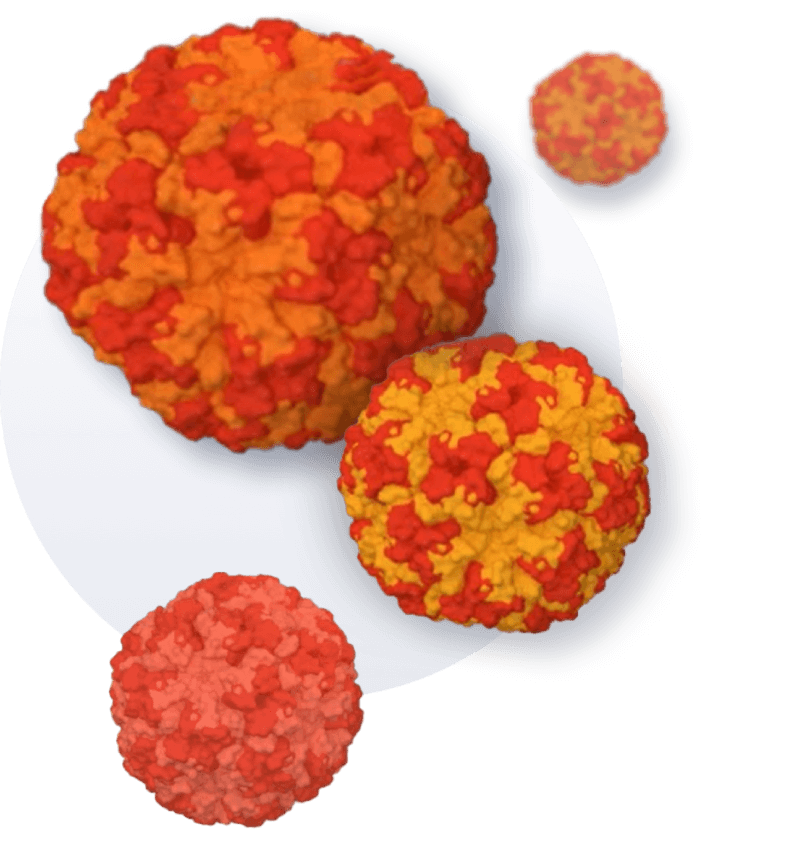Where are travellers potentially at risk?
Search for a destination to find out:
Dengue Risks and Severity
The information presented is based on the latest data provided by the Centers for Disease Control and Prevention dated January 20th, 2023. [2]
Data is not available for every country
What are the risks to travellers?
The risk of dengue exists in areas where the mosquito vectors are present.[1, 2] Unlike some other vector borne diseases, they can thrive in both urban and rural areas, indoors and outdoors throughout the day.[1, 3, 4]
While 75% of dengue infections are mild or asymptomatic, dengue infections can occasionally lead to a severe form of the disease.[1]
40% [n=2119/5009] of returning travellers who were ill with dengue were hospitalised, according to one study*[5]
According to one study*, 40% (n=2119/5009) of returning travellers who were ill with dengue were hospitalised (a very small percentage [<1% (n=46/5,009)] of patients in this study had severe dengue.) [5]
- From 2000-2011 studies reported dengue as being the leading cause of febrile illness among ill travellers returning from Southeast Asia, Latin America and the Caribbean[7]
- Approximately 1% of travellers who were infected developed severe dengue (n=46/5,009), it was fatal in about 0.3% (n=18/5,009) of cases (2010–2017)[5]
Around20%[n=20/90] required hospitalisation in their travel destination[7]
Another study reported that of returning travellers (including Europeans) who presented to a medical clinic with dengue-related illness, approximately 40% (n=35/90) were hospitalised. [7]
- Around 20% (n=20/90) required hospitalisation in their travel destination [7, 8]
*Data from US based study.
Even short stays in dengue-endemic areas are associated with a risk of becoming infected, and this risk increased with longer stays and return travel to endemic areas. [8, 9] For your travellers, this could mean an unwelcome derailment to holiday plans.
Travellers at risk
Dengue can affect people of all ages and ethnicities, [1, 11] however, some may be at a higher risk of developing severe dengue than the general population, such as:
People with underlying medical conditions like diabetes mellitus and renal disease[12], who were found to be three times more likely to develop severe dengue.[12]
People previously infected with dengue once before, who were found to be three times more likely to develop severe dengue.[12]
People revisiting endemic areas[13]
People who are obese[14][15]
People in older age groups.[16]
Dengue fever: the statistics
It has been shown that travellers have a higher risk of contracting dengue compared with other diseases that are regularly vaccinated against before travel [8, 16, 17]
Figure adapted from Steffen R, et al. J Travel Med. 2018;25(1):1-3
* Diseases positioned by Prof Steffens personal assessment and based on epidemiological studies on individual infectious diseases. Dengue incidence per month added and calculated as per Ratnam I, et al. Journal of Travel Medicine. 2013;20(6):384–393, by dividing 1,000 person-months by 1,000 (study period 1991-2010).
It’s time to talk to travellers about dengue
Download this free factsheet to help you to answer the most common queries about dengue
Download now
How severe is dengue?
While most dengue infections are asymptomatic, around 25% of dengue-infected people develop symptomatic infections. [1, 20] Dengue symptoms can vary greatly, ranging from mild, undifferentiated fever to flu-like symptoms and joint and muscle pains. [1] This can make dengue difficult to spot, so it's important we all know the risks.
25% of dengue infected people develop symptomatic infections[1, 20]
Approximately 1 in 20 people with dengue infection develop severe disease. Although uncommon, severe cases can lead to organ impairment and/or plasma leakage, which may lead to hospitalisation and death. [2]
- No symptoms 75%
- Present with symptoms 20%
- Of people who present with symptoms, approximately 1 in 20 develop severe symptoms
Approximately 1 in 20 people with dengue infection develop severe disease.[2]
Two variants of severe dengue exist: [19]
dengue hemorrhagic fever and dengue shock syndrome
People who develop dengue hemorrhagic fever have a 5% chance of death, but this can be as high as 40% if dengue shock syndrome develops. [20]
up to40% chance of death if dengue shock syndrome develops [20]
Comorbidity risk factors
One population-based study found underlying chronic diseases exacerbate the course of acute dengue, resulting in a higher frequency of and prolonged duration of hospitalisation, greater need for ICU care, and a higher risk of fatal outcome. [21]
Comorbidities identified included advanced age, obesity and underlying noncommunicable diseases.[21] The study found an increased risk for death in the 30 days after dengue diagnosis occurred in patients with underlying malignancy, congestive heart failure (CHF), chronic obstructive pulmonary disease (COPD), asthma, rheumatic diseases, chronic kidney disease (CKD), and cirrhosis. [20]
It’s important to remember – subsequent dengue infection with another serotype can increase the risk of developing severe dengue. [1, 12]
Based on one analysis, prior dengue infection can increase the risk of developing severe dengue by three times compared to those not previously infected. [12]
Even though around 75% of dengue infections are silent and show no symptoms, asymptomatic travellers can still be at risk of developing severe dengue if they are infected again with a different serotype later. [1, 20]
Why is this?
This is because the dengue virus has four different serotypes. After infection with one serotype, immunity against the other three serotypes is only partial and temporary, meaning a person can be infected more than once if they are exposed to a different serotype. Secondary infection with another serotype can increase the risk of developing severe dengue. [1]

Where is dengue?
Find detailed information and a country-by-country breakdown on dengue prevalence.
Explore the toolPrevent and protect
Learn how you can help to prevent the spread and protect your travellers.
Prevent dengueWant to know more?
Sign-up to TakedaID to stay informed about dengue and help you advise travellers.
Sign up for updatesGB & NI: Adverse events should be reported. Reporting forms and information can be found at: www.mhra.gov.uk/yellowcard.
ROI: Adverse events should be reported to the Pharmacovigilance Unit at the Health Products Regulatory Authority. Reporting forms and information can be found at: www.hpra.ie.
GB, NI and ROI: Adverse events should also be reported to Takeda UK Ltd at: AE.GBR-IRL@takeda.com
References
- WHO. Dengue and severe dengue factsheets. Available at: https://www.who.int/news-room/fact-sheets/detail/dengue-and-severe-dengue [Accessed January 2023].
- Centers for Disease Control and Prevention. Dengue Around the World. https://www.cdc.gov/dengue/areaswithrisk/around-the-world.html. [Accessed January 2023].
- World Health Organization. Dengue guidelines for diagnosis, treatment, prevention, and control. New edition 2009. Available at: https://apps.who.int/iris/handle/10665/44188 [Accessed January 2023].
- Lowe R, et al. Combined effects of hydrometeorological hazards and urbanization on dengue risk in Brazil: a spatiotemporal modelling study. Lancet Planet Health. 2021;5:e209–19.
- Rivera A, et al. Travel-Associated and Locally Acquired Dengue Cases - United States, 2010-2017. MMWR Morb Mortal Wkly Rep. 2020;69(6):149–154.
- WHO. Dengue and severe dengue factsheets. Available at: https://www.who.int/news-room/fact-sheets/detail/dengue-and-severe-dengue [Accessed January 2023].
- Tozan Y, et al. A Prospective Study on the Impact and Out-of-Pocket Costs of Dengue Illness in International Travellers. Am. J. Trop. Med. Hyg. 2019;100(6):1525–1533.
- Halstead S, Wilder-Smith A. Severe dengue in travellers: pathogenesis, risk and clinical management. J Travel Med. 2019;26(7):taz062.
- Yang X, et al. Global burden for dengue and the evolving pattern in the past 30 years. J Travel Med. 2021;28(8):taab146.
- NHS: Fit For Travel. Mosquito Bite Avoidance. Available at: https://www.fitfortravel.nhs.uk/advice/malaria/mosquito-bite-avoidance. [Accessed January 2023].
- Jing Q and Wang M. Dengue epidemiology. Glo Health J. 2019;3(2):37–45.
- Tsheten T, et al. Clinical predictors of severe dengue: A systematic review and meta-analysis. Infect Dis Poverty. 2021;10(1):123.
- Bulugahapitiya U, Siyambalapitiya S, Seneviratne SL, Fernando DJ. Dengue fever in travellers: A challenge for European physicians. Eur J Intern Med. 2007;18(3):185-92.
- P. Gallagher, K.R. Chan and L. Rivino et al. Journal of Infection. 81 (2020) 10–16 11.
- Badawi A, Velummailum R, Ryoo SG, Senthinathan A, Yaghoubi S, Vasileva D, Ostermeier E, Plishka M, Soosaipillai M, Arora P, 2018. Prevalence of chronic comorbidities in dengue fever and West Nile virus: a systematic review and meta-analysis. PLoS One 13:e0200200
- Lien CE, Chou YJ, Shen YJ, Tsai T, Huang N. A Population-Based Cohort Study on Chronic Comorbidity Risk Factors for Adverse Dengue Outcomes. Am J Trop Med Hyg. 2021 Sep 27;105(6):1544-1551. Doi: 10.4269.
- Ratnam I, et al. Dengue fever and international travel. J Travel Med. 2013;20(6):384–93.
- Steffen R. Travel vaccine preventable diseases-updated logarithmic scale with monthly incidence rates. J Travel Med. 2018;25(1).
- Gossner CM, et al. Dengue virus infections among European travellers, 2015 to 2019. Euro Surveil. 2022;27(2):2001937.
- World Health Organization. Dengue around the world. Available at: https://www.euro.who.int/__data/assets/pdf_file/0009/234198/Dengue-in-the-WHO-European-Region.pdf [Accessed January 2023].
- Lien C, et al. Population-Based Cohort Study on Chronic Comorbidity Risk Factors for Adverse Dengue Outcomes. Am. J. Trop. Med. Hyg. 2021;105(6):1544-1551.
C-APROM/GB/DENV/0020 | Date of preparation: March 2023






